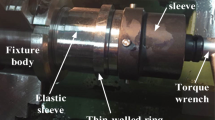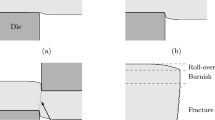Abstract
The superposition effect of various cutting mechanisms (CM) in the fine drilling process brings great challenges to the accurate characterization of the cutting stress field of the workpiece. To solve the above problem, the cutting stress characterization modeling and parameter identification for the fine drilling process with multiple cutting mechanisms is studied in this paper. Firstly, two cutting mechanisms (shear-slip and plough-slip) are distinguished according to the relative tool sharpness (RTS) which is determined by the cutting tool radius and cutting depth, and the fine characterization model for drilling stress of the workpiece is constructed by considering the two cutting mechanisms. Then, in order to overcome the problem that model parameters are difficult to be accurately determined, the sub-interval decomposition optimization method (SDOM) and the improved particle swarm optimization (PSO) are employed to identify parameters in the model. Finally, the proposed method is verified by comparing the single cutting mechanism model, the multiple cutting mechanisms model, and the actual characterization parameter model.





















Similar content being viewed by others
Abbreviations
- σ :
-
Total stress (MPa)
- σ i :
-
The stress of the i-th cutting element (MPa)
- φ :
-
Half point angle (°)
- t c :
-
The undeformed chip thickness (mm)
- r c :
-
The edge radius (mm)
- σ s, τ s :
-
The normal and tangential stress in shearing zone (MPa)
- k s :
-
The shear yield strength (GPa)
- σ max :
-
The max normal contact stress (MPa)
- F v, F f :
-
The thrust force in the cutting and feed direction (N)
- A, B :
-
The length of the shearing and rubbing zone (mm)
- B 1, B 2 :
-
The length of the first and second rubbing zone (mm)
- φ s :
-
The shear angle (°)
- a w :
-
The cutting width (mm)
- σ r, τ r :
-
The normal and tangential stress in the rubbing zone (MPa)
- σ 0, τ 0 :
-
The max normal and tangential stress of the cutting edge (MPa)
- F r 1, F r 2 :
-
The rubbing force of the flank and rake face (N)
- μ :
-
The friction coefficient
- E w, E t :
-
The elastic modulus of workpiece and tool (MPa)
- υ w, υ t :
-
The Poisson’s ratio of workpiece and tool
- F h :
-
The hydrostatic pressure of the target point (N)
- F b :
-
The physical strength of the workpiece (N)
- F t :
-
The tensile surface traction of cutting boundary points (N)
- T :
-
The temperature (℃)
- α :
-
The linear expansion coefficient of the workpiece (1/℃)
- G :
-
The Green’s functions
- S ij, α ij :
-
The deviatoric stresses and backstresses (MPa)
- h, c :
-
The isotropic hardening coefficient and the kinematic hardening coefficient
- κ :
-
The plastic modulus
- p w :
-
The ploughing thickness of the workpiece (mm)
- γ n :
-
The normal rake angle (°)
- X :
-
The difference degree matrix
- X 1 ~ X 6 :
-
The difference degrees
- A act ~ μ act :
-
The actual characterization parameters
- e :
-
The difference degree evaluation function
- mut :
-
The mutation operator of the elite population
- P c, P g :
-
The two operator selection rates of the normal population
- sel c, sel g :
-
The number of Cauchy mutation and Gaussian mutation
- β i :
-
The weight coefficient of each experimental data
- ε i :
-
The relative error of each predicted and experimental data
- C :
-
The reliability of the models
References
Outeiro JC, Umbrello D, Saoubi RM (2006) Experimental and numerical modelling of the residual stresses induced in orthogonal cutting of AISI 316L steel. Int J Mach Tools Manuf 46(14):1786–1794. https://doi.org/10.1016/j.ijmachtools.2005.11.013
Ulutan D, Alaca BE, Lazoglu I (2007) Analytical modelling of residual stresses in machining. J Mater Process Technol 183(1):77–87. https://doi.org/10.1016/j.jmatprotec.2006.09.032
Lazoglu I, Ulutan D, Alaca BE, Engin S, Kaftanoglu B (2008) An enhanced analytical model for residual stress prediction in machining. CIRP Ann - Manuf Technol 57(1):81–84. https://doi.org/10.1016/j.cirp.2008.03.060
Munoz-Sanchez A, Canteli JA, Cantero JL, Miguelez MH (2011) Numerical analysis of the tool wear effect in the machining induced residual stresses. Simul Model Pract Theory 19(2):872–886. https://doi.org/10.1016/j.simpat.2010.11.011
Agmell M, Ahadi A, Gutnichenko O, Stahl JE (2017) The influence of tool micro-geometry on stress distribution in turning operations of AISI 4140 by FE analysis. Int J Adv Manuf Technol 89(9–12):1–14. https://doi.org/10.1007/s00170-016-9296-7
Zhang WQ, Wang XL, Hu YJ, Wang SY (2018) Predictive modelling of microstructure changes, micro-hardness and residual stress in machining of 304 austenitic stainless steel. Int J Mach Tools Manuf 130:36–48. https://doi.org/10.1016/j.ijmachtools.2018.03.008
Wika KK, Litwa P, Hitchens C (2019) Impact of supercritical carbon dioxide cooling with Minimum Quantity Lubrication on tool wear and surface integrity in the milling of AISI 304L stainless steel. Wear 426–427:1691–1701. https://doi.org/10.1016/j.wear.2019.01.103
Liu Y, Xu DD, Agmell M, Ahadi A, Stahl JE, Zhou JM (2021) Investigation on residual stress evolution in nickel-based alloy affected by multiple cutting operations. J Manuf Process 68:818–833. https://doi.org/10.1016/j.jmapro.2021.06.015
Liu Y, Xu D, Agmell M, Saoubi RM, Ahadi A, Stahl JE (2021) Numerical and experimental investigation of tool geometry effect on residual stresses in orthogonal machining of Inconel 718. Simul Model Pract Theory 106:102187. https://doi.org/10.1016/j.simpat.2020.102187
Yao GH, Liu ZQ, Song QH, Wang B, Cai YK (2022) Numerical prediction and experimental investigation of residual stresses in sequential milling of GH4169 considering initial stress effect. Int J Adv Manuf Technol 119(11–12):7215–7228. https://doi.org/10.1007/s00170-022-08740-0
Liu ZH, Zhang J, Zhou SW, Li XH, Liu K (2013) Coevolutionary particle swarm optimization using AIS and its application in multiparameter estimation of PMSM. IEEE Trans Cybern 43(6):1921–1935. https://doi.org/10.1109/TSMCB.2012.2235828
Liu ZH, Wei HL, Zhong QC, Liu K, Xiao XS, Wu LH (2017) Parameter estimation for VSI-Fed PMSM based on a dynamic PSO with learning strategies. IEEE Trans Power Electron 32(4):3154–3165. https://doi.org/10.1109/TPEL.2016.2572186
Vaz M, Muñoz-Rojas PA, Cardoso EL, Tomiyama M (2016) Considerations on parameter identification and material response for Gurson-type and Lemaitre-type constitutive models. Int J Mech Sci 106:254–265. https://doi.org/10.1016/j.ijmecsci.2015.12.014
Scotti T, Wirgin A (2014) Multiparameter identification of a lossy fluid-like object from its transient acoustic response. Inverse Probl in Sci Eng 22(8):1228–1258. https://doi.org/10.1080/17415977.2013.867485
Su GY, Wang PY, Guo YC, Cheng G, Wang S, Zhao DY (2022) Multiparameter identification of permanent magnet synchronous motor based on model reference adaptive system—simulated annealing particle swarm optimization algorithm. Electron 11(1):159. https://doi.org/10.3390/electronics11010159
Wang ZL, Ogawa T, Adachi Y (2019) Influence of algorithm parameters of Bayesian optimization, genetic algorithm, and particle swarm optimization on their optimization performance. Adv Theory Simul 2(10):1900110. https://doi.org/10.1002/adts.201900110
Walters DJ, Biswas A, Lawrence EC, Francom DC, Luscher DJ, Fredenburg DA, Moran KR, Sweeney CM, Sandberg RL, Ahrens JP, Bolme CA (2018) Bayesian calibration of strength parameters using hydrocode simulations of symmetric impact shock experiments of Al-5083. J Appl Phys 124(20):205105. https://doi.org/10.1063/1.5051442
Kuhn J, Spitz J, Sonnweber-Ribic P, Schneider M, Bohlke T (2022) Identifying material parameters in crystal plasticity by Bayesian optimization. Optim Eng 23(3):1489–1523. https://doi.org/10.1007/s11081-021-09663-7
Wang J, Xiao Y, Kawai M (2018) Parameter identification problem in one-parameter plasticity model for fibrous composites. Adv Compos Mater 28(2):29–51. https://doi.org/10.1080/09243046.2018.1448684
Ouyang H, Liu J, Han X, Ni BY, Liu GR, Lin YX (2021) Non-probabilistic uncertain inverse problem method considering correlations for structural parameter identification. Struct Multidiscip Optim 64(3):1327–1342. https://doi.org/10.1007/s00158-021-02920-4
Fu CM, Cao LX, Tang JC, Long XY (2017) A subinterval decomposition analysis method for uncertain structures with large uncertainty parameters. Comput Struct 197:58–69. https://doi.org/10.1016/j.compstruc.2017.12.001
Chandrasekharan V, Kapoor SG, Devor RE (1995) A mechanistic approach to predicting the cutting forces in drilling: with application to fiber-reinforced composite materials. J Eng Ind 117(4):559–570. https://doi.org/10.1115/1.2803534
Rahman MA, Amrun MR, Rahman M, Kumar AS (2017) Variation of surface generation mechanisms in ultra-precision machining due to relative tool sharpness (RTS) and material properties. Int J Mach Tools Manuf 115:15–28. https://doi.org/10.1016/j.ijmachtools.2016.11.003
Xiong LS, Li B (2016) The energy conservation optimization design of the cutting edges of the twist drill based on Dijkstra’s algorithm. Int J Adv Manuf Technol 82(5–8):889–900. https://doi.org/10.1016/10.1007/s00170-015-7165-4
Fang N (2003) Slip-line modeling of machining with a rounded-edge tool-part I: new model and theory. J Mech Phys Solids 51(4):715–742. https://doi.org/10.1016/S0022-5096(02)00060-1
Agrawal S, Joshi SS (2013) Analytical modelling of residual stresses in orthogonal machining of AISI4340 steel. J Manuf Process 15(1):167–179. https://doi.org/10.1016/j.jmapro.2012.11.004
Smithey DW, Kapoor SG, DeVor RE (2000) A worn tool force model for three-dimensional cutting operations. Int J Mach Tools Manuf 40(13):1929–1950. https://doi.org/10.1016/S0890-6955(00)00017-1
Saif M, Hui C, Zehnder A (1993) Interface shear stresses induced by non-uniform heating of a film on a substrate. Thin Solid Films 224(2):159–167. https://doi.org/10.1016/0040-6090(93)90427-Q
Jiang YY, Sehitoglu H (1994) An analytical approach to elastic-plastic stress analysis of rolling contact. J Tribol - Trans ASME 116(3):577–587. https://doi.org/10.1115/1.2928885
Chen L, El-Wardany TI, Harris WC (2004) Modelling the effects of flank wear land and chip formation on residual stresses. CIRP Ann - Manuf Technol 53(1):95–98. https://doi.org/10.1016/S0007-8506(07)60653-2
Tang BT, Lu XY, Wang ZQ, Zhao Z (2010) Springback investigation of anisotropic aluminum alloy sheet with a mixed hardening rule and Barlat yield criteria in sheet metal forming. Mater Des 31(4):2043–2050. https://doi.org/10.1016/j.matdes.2009.10.017
Yu JW, Fei QG, Zhang PW, Li YB, Zhang DH, Guo F (2019) An innovative yield criterion considering strain rates based on Von Mises stress. J Press Vessel Technol - Trans ASME 142(1):014501. https://doi.org/10.1115/1.4044908
Hoger A (1986) On the determination of residual stress in an elastic body. J Elast 16(3):303–324. https://doi.org/10.1007/BF00040818
Sambhav K, Tandon P, Kapoor SG, Dhande SG (2013) Mathematical modeling of cutting forces in microdrilling. J Manuf Sci Eng - Trans ASME 135(1):014501. https://doi.org/10.1115/1.4007955
Yan L, Yang WY, Jin HP, Wang ZG (2012) Analytical modeling of the effect of the tool flank wear width on the residual stress distribution. Mach Sci Technol 16(2):265–286. https://doi.org/10.1080/10910344.2012.673973
Morin E, Masounave J, Laufer EE (1995) Effect of drill wear on cutting forces in the drilling of metal-matrix composites. Wear 184(1):11–16. https://doi.org/10.1016/0043-1648(94)06541-1
Wang CS, Li XL, Guo L, Li YW (2012) A seamless operation mode transition control strategy for a microgrid based on master-slave control. Sci China-Technol Sci 55(6):1644–1654. https://doi.org/10.1007/s11431-012-4811-z
Jiang F, Xia HY, Tran QA, Ha QM, Tran NQ, Hu JK (2017) A new binary hybrid particle swarm optimization with wavelet mutation. Knowl - Based Syst 130:90–101. https://doi.org/10.1016/j.knosys.2017.03.032
Wang H, Wang WJ, Wu ZJ (2013) Particle swarm optimization with adaptive mutation for multimodal optimization. Appl Math Comput 221:296–305. https://doi.org/10.1016/j.amc.2013.06.074
Acknowledgements
This research is supported by the State Department project of China (Grant No. JF2020-1-0422). The authors gratefully acknowledge the facilities provided by the Industrial and Intelligent System Engineering Laboratory (IISEL) at the Beijing Institute of Technology.
Author information
Authors and Affiliations
Contributions
All authors contributed to the conception and design of the study. Kuikui Feng proposed the original modeling and analysis method, Faping Zhang improved the research method, Wuhong Wang conceived the experimental method, and Zhenhe Wu, Mengdi Zhang, and Biao Wang analyzed and organized the experimental data. The first draft was written by Kuikui Feng, and all the authors commented on the previous version. All authors read and approved the final manuscript.
Corresponding author
Ethics declarations
Competing interests
The authors declare no competing interests.
Additional information
Publisher's Note
Springer Nature remains neutral with regard to jurisdictional claims in published maps and institutional affiliations.
Rights and permissions
Springer Nature or its licensor (e.g. a society or other partner) holds exclusive rights to this article under a publishing agreement with the author(s) or other rightsholder(s); author self-archiving of the accepted manuscript version of this article is solely governed by the terms of such publishing agreement and applicable law.
About this article
Cite this article
Feng, K., Zhang, F., Wang, W. et al. Cutting stress modeling and parameter identification for fine drilling process based on various cutting mechanisms. Int J Adv Manuf Technol 132, 759–779 (2024). https://doi.org/10.1007/s00170-024-13197-4
Received:
Accepted:
Published:
Issue Date:
DOI: https://doi.org/10.1007/s00170-024-13197-4




